5 lessons from season 2 of the People Leading People Podcast
In season 2, we asked our speakers to go in-depth into particular topics like remote management, psychological safety and leadership styles. These are the biggest lessons we've learned this season.
Warning: Undefined array key "category" in /www/hypercontext_216/public/wp-content/themes/Soapbox/hype-files/sections/article/content.php on line 10
We can hardly believe that only a few weeks ago we released our second season of the People Leading People podcast! When we started the podcast, we didn’t want to be just “another business podcast” with general management and fluffy leadership advice.
We wanted to talk to real leaders about their real struggles and successes building their teams and companies. We did just that.
This season we brought on 5 amazing leaders to go as deep as they could on a particular topic so that they never had to talk about it again. Speakers include:
- Eoghan McCabe, CEO and Co-Founder of Intercom
- Katie Womersley, VP of Engineering at Buffer
- Mark Roberge, Former CRO of HubSpot
- Camille Fournier, Former CTO of Rent the Runway
- Michael Lopp, Former VP of Product Engineering at Slack
Jump to a specific lesson 👇
- Eoghan McCabe: Find your authentic leadership style
- Katie Womersley: Communication is your job
- Mark Roberge: Sales managers should focus on hiring and coaching
- Camille Fournier: Manager READMEs can be helpful, but only when done right
- Michael Lopp: The importance of psychological safety
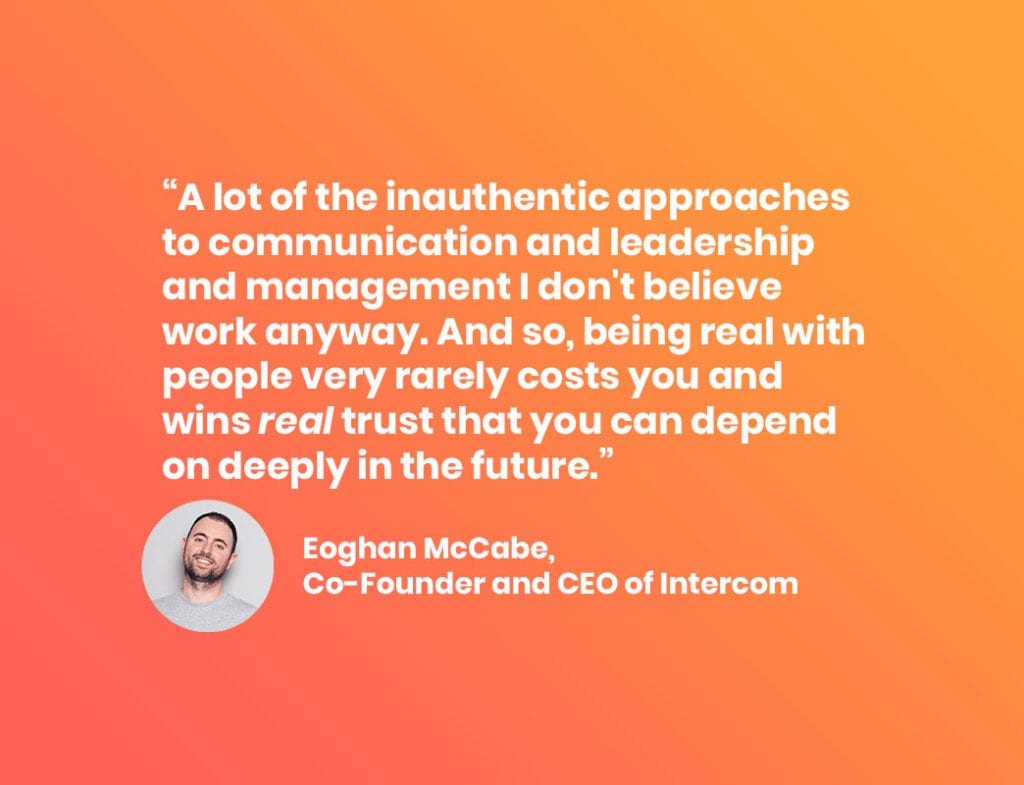
Lesson #1: Find your authentic leadership style
In episode 1, we sat down with Eoghan McCabe to discuss how leaders can find their authentic leadership style. Eoghan found himself playing the part of CEO at Intercom at several different stages of the company (from 1 employee to now 800+ employees). What was expected from him at every stage of growth, and how he should act changed drastically the more the company grew.
As a self-proclaimed technology and electronics nerd, it can sometimes be hard to be your true authentic self, while trying to fit the mold into how people expect a CEO to act. McCabe puts it best:
“There are a whole bunch of ideas in this industry about what you’re supposed to do […] and if you wanted to be your true authentic self, you’re going to end up bumping against them. Or, put another way, if you’re going to be honest with the fact that you are unique in the world amongst these 7 billion odd people, you’re not always going to fit into these status quo ideas.”
-Eoghan McCabe, CEO and Co-Founder of Intercom
To give you an example, Eoghan describes his authentic leadership style as:
“I try and be direct with people. I try to be open and honest. I try and be vulnerable and let people know when I’m worried and scared. I try to not take myself too seriously. I try to be open about my desire to do things in love and in kindness. I try to show gratitude when it is appropriate, and it’s always appropriate. But, you know, when people do particularly good work I want to make sure that that’s recognized. I try to apologize when I’ve made mistakes. I try to let people know I don’t have all the answers. I try to bring people into the conversations that matter to them. I try to not shy away from telling people things that they don’t want to hear and I try and promote an independent approach to thinking such that I can be more open, honest, and direct.”
-Eoghan McCabe, CEO and Co-Founder of Intercom
So the lesson here: It’s okay when your authentic self doesn’t fit exactly into the mold of what a leader is. All that’s important is that you try to be a good leader and that you’re staying true to yourself in the process (unless you’re a mean person; don’t be mean to your colleagues).
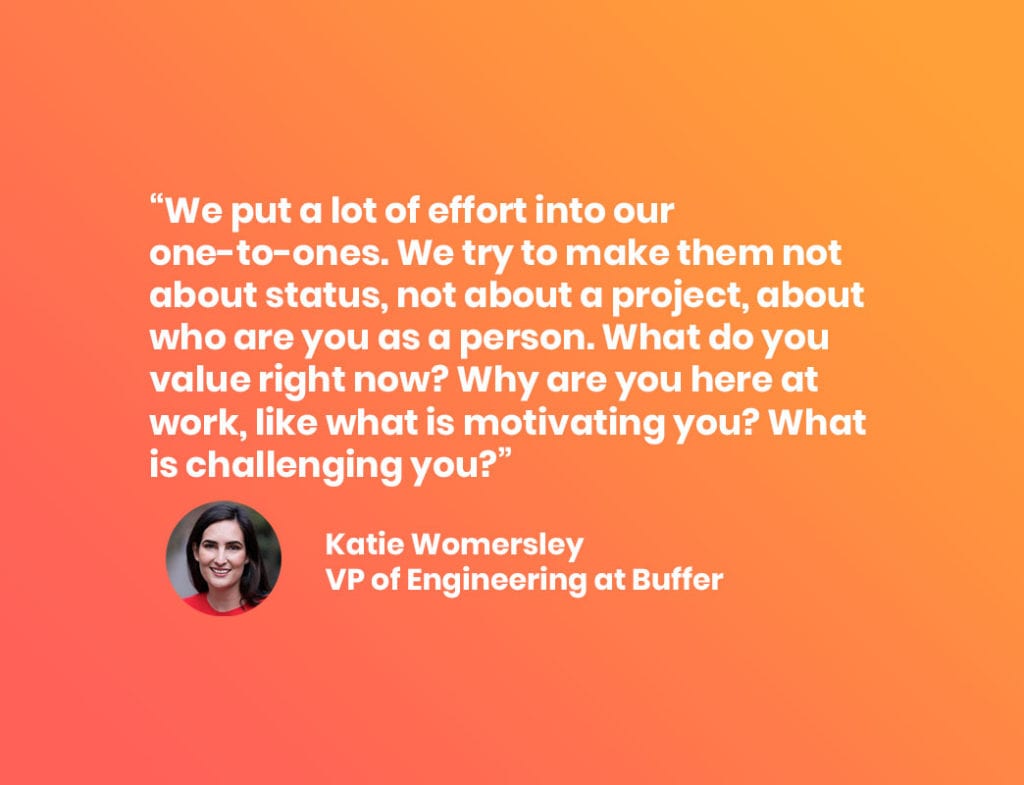
Lesson #2: Communication is your job
In Episode 2, we sat down with Katie Womersley of Buffer to discuss how she manages an entirely remote team. Katie was an ideal person to discuss this with considering that Buffer is 100% remote. When she first started at Buffer, Katie was a software engineer. Over the years, she moved up in the organization to where she is today, VP of Engineering.
The transition from individual contributor to manager can be extremely tough. For a lot of managers, at least on smaller teams, your job is likely a mix of individual-contributor type work, as well as management-specific work. Regardless of your team’s size, as a new or tenured manager, you may feel obligated to do things like write code or content, design things, etc. But in reality, your job is to communicate with your team.
We asked Katie: If you were to go back in time and give yourself one piece of advice on how to be a better remote employee, what would you tell yourself? Here’s what she had to say:
“I think I would tell myself that the work I did to keep my team informed and to be very communicative was my job and was my work. That was something that would often stress me out a lot because I had this idea of, well I need to code for 8 hours. And then all of the time that it takes to keep my team informed, to keep Jira tickets up to date, to send screenshots of my work, put things on dev service, I would then do that like in the after hours. I didn’t realize that was sort of part of the job. So, it was incredibly stressful.
I didn’t realize like, when were you supposed to do this communicating? So, I think if I were to go back in time, I would say, ‘That is the job, if you’re a remote employee, communicating really well with your team.’ They should never wonder what’s going on with you.”
-Katie Womersley, VP Engineering at Buffer
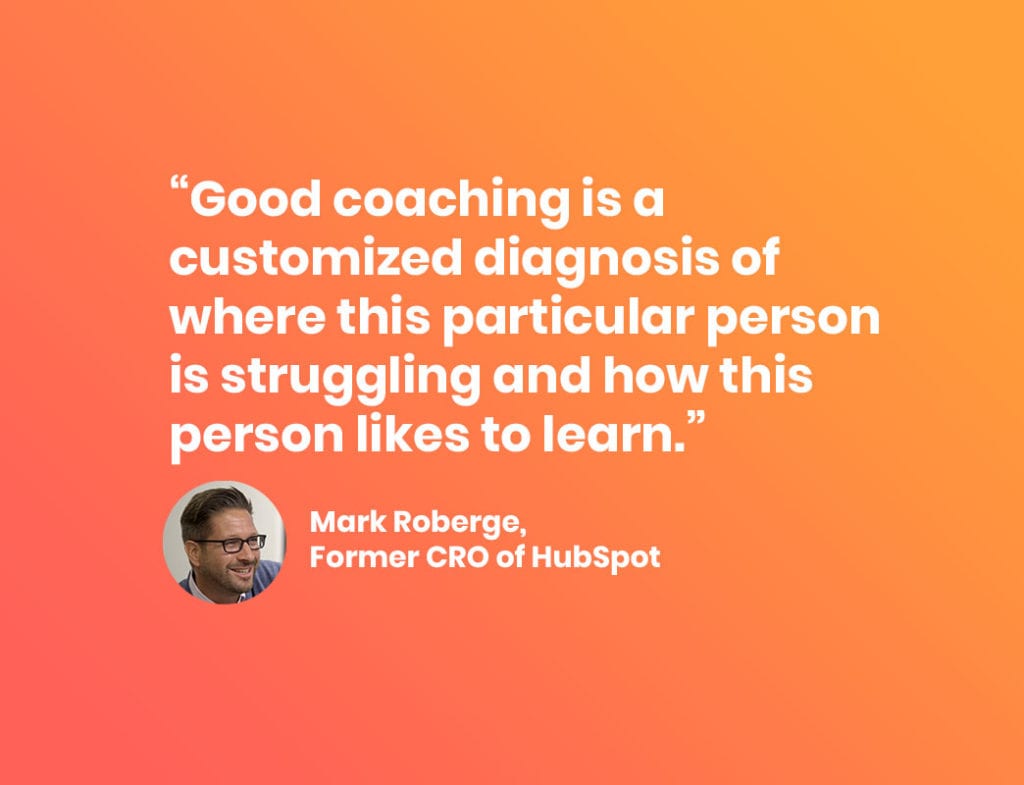
Lesson #3: Sales managers should focus on hiring and coaching
For many sales teams (excluding full-cycle sales reps), the very high-level sales process is:
- BDR/SDR calls prospects and books demos
- Account executives run demos and close deals
- Sales managers “oversee” everything (you’ll see why it’s in quotes in a second)
However, when we spoke with Mark Roberge, former CRO of HubSpot, in episode 3, his view on the matter was more along the lines of this being an unscalable way to run a sales team. He saw that the role of the sales manager was unscalable and the jobs/tasks that they were doing were either detrimental to their team’s productivity and success, or could be easily automated.
To the first point of being detrimental to the team’s productivity and success, Roberge saw that rather than coaching the team, sales managers were essentially doing the job for the reps. They would go to the meetings, run them and it just wasn’t helpful to the reps or the organization.
“It really made the reps lazy and not confident because the manager could usually do it better than them. And that just was really detrimental to the scale of the business.”
-MARK ROBERGE, FORMER CRO OF HUBSPOT
He also said that,
“the other thing [sales managers] did was they spent a lot of time putting together the forecast, which technology can do that today. Better than a human, honestly.”
-Mark Roberge, Former CRO of HubSpot
So what’s the lesson for sales leaders? Mark shared his two-cents:
“And so I thought about what I want my sales managers to do and boiled down the job to two things which are: hire and coach, hire and coach. If they can hire and coach, and develop their people, they’re just going to be really successful. And I didn’t feel like there was a lot of like coaching that was going on from the managers that I observed across the industry.”
-Mark Roberge, Former CRO of HubSpot
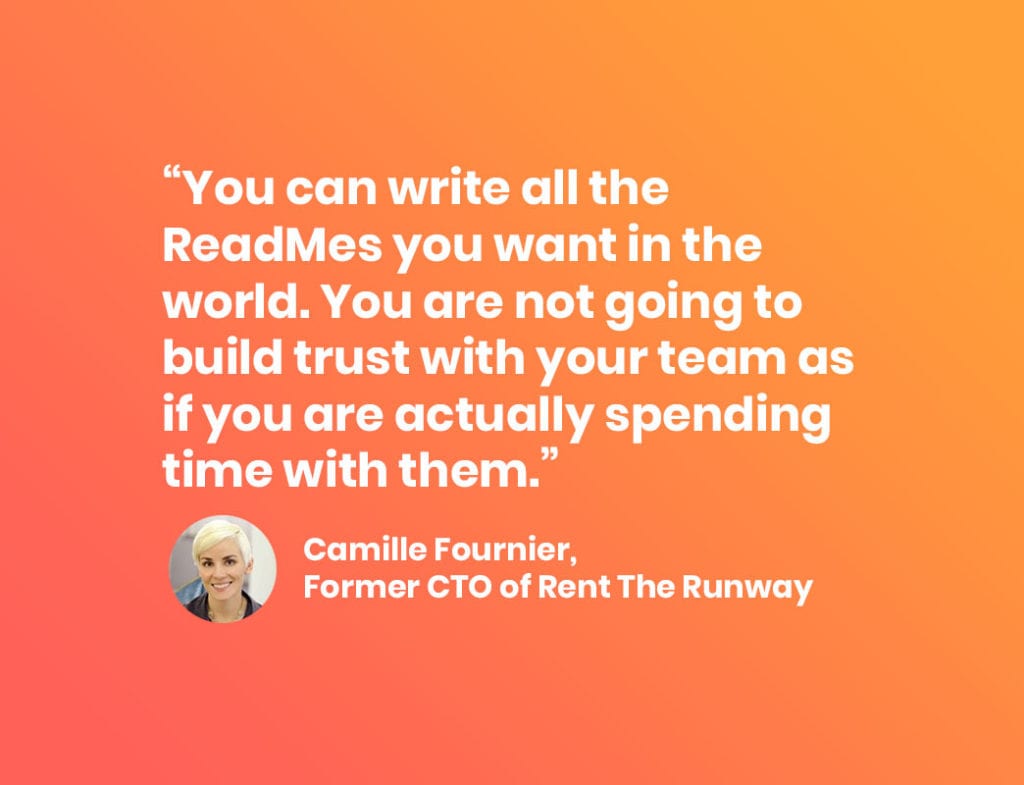
Lesson #4: Manager READMEs can be helpful, but only when done right
In episode 4, we sat down with Camille Fournier, former CTO of Rent the Runway to discuss her stance on manager READMEs. This document, also known as a “How I like to work doc”, is something that managers create and share with their direct reports, covering things like their work hours, personality traits, quirks and more.
While this can be a powerful tool for self-reflection and rapidly onboarding new direct reports, when misused they can seriously damage the relationship between managers and their team. Camille puts it best:
“I’ve seen this happen. I’ve probably done this to people. You project a particular image. You say a particular thing. You say, “I’m really open to feedback, come give me feedback, come give me feedback. Somebody believes you, naively. They come and give you feedback, and then you get mad or you react poorly or you, you know, you punish them in some way. “And [your direct report] realizes, ‘Holy crap. I’ve now damaged my relationship with my manager because I thought that they said [they were great at receiving feedback] and they just aren’t.’”
-Camille Fournier, Former CTO of Rent the Runway
When it comes to Manager READMEs, they’re only helpful when you do them right, and more importantly to do it honestly. When you finish creating a README, it doesn’t necessarily mean that you have to share it with your team. You can try sharing it with another manager and get their feedback. You can also choose to not share it at all and use it as a personal exercise for self-reflection and goal-setting.
“The thing that I do think is very valuable about doing this README exercise, you don’t have to share it with your team. You can write it down and say these are, this is what I want to be. Like as a leader, I want to be these things and then write that down and you know every month or so ask yourself, “Am I being that leader that I said I wanted to be? These are the ideals that I hold. These are things I believe in myself. Am I being true to myself?” You know, I think that’s another, that’s a very useful part of this exercise that I would absolutely recommend everyone do.”
-Camille Fournier, Former CTO of Rent the Runway
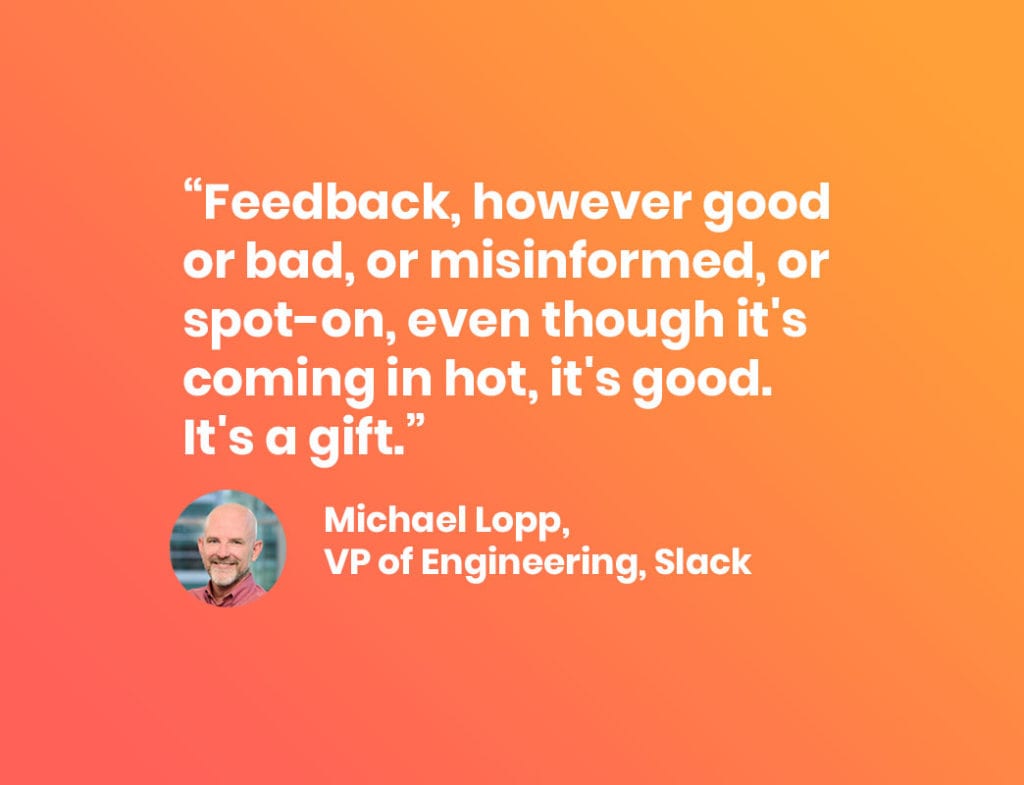
Lesson #5: The importance of psychological safety on a team
In the final episode this season, we sat down with Michael Lopp, Former VP of Product Engineering at Slack to discuss not only the importance of fostering a culture of psychological safety on your team but how to do it as well.
When psychological safety is high, people tend to feel more comfortable to be their true selves. They’ll open up more about ideas, feedback and generally be happier (which often leads to higher productivity).
But as a manager psychological safety can be hard to foster. In this episode, Michael Lopp shares what he’s learned from his time at Apple, Pinterest, and Slack when it comes to sharing hard feedback with your team while maintaining an environment where people feel safe enough to say, “No.”
Why do I say no or how do I say no? Here’s the thing. You’ve got to have something before that step, which is your vision or your strategy. These are the things I’m working on and I’m really, really clear about those things. At Slack, I tell you what they [those things] are and it’s five huge things.
I can tell you the story about why they’re important and when you come to me and say, “Hey blah, blah, blah. This thing… It’s gonna be a lot of work.” I go in my head I’m like, do you really believe these five things are the most important thing? And the answer is yes, I do. Well, maybe I don’t. Maybe the thing you’re asking is more important than that, but that is how I start with the no, is being really clear about: What are my objectives? What are the things I’m trying to do? And when I when I say no to you, I say no. I don’t say “No, I’m the boss.” I say, “No and here’s why. These five things and the thing you asked me to do is going to take a week. These five things are far more important, do we agree? And if not, let’s have that debate.”
-Michael Lopp, Former VP of Product Engineering at Slack
What we’ve learned from Michael is that… Yes, you may be the boss and you may have experience and context into certain decisions. But you’ve hired a team of people that you trust and that you feel are (at the bare minimum) competent enough to do the job, and do it well. So, creating a space where people feel comfortable challenging decisions is great because it allows the team to have the necessary conversations and perspectives that it needs to achieve greatness. The language that you use should never be “I’m the boss and what I say goes.” But rather, “here’s the context that I have and why the idea we’re moving forward with is what’s best for the team and the organization.”
Check out all of our episodes 👇
What to do next
Now that you've read this article, here are some things you should do:
- You should check out our YouTube channel for more tips on management skills and team building.
- Check out Spinach to see how it can help you run a high performing org.
- If you found this article helpful, please share it with others on Linkedin or X (Twitter)
